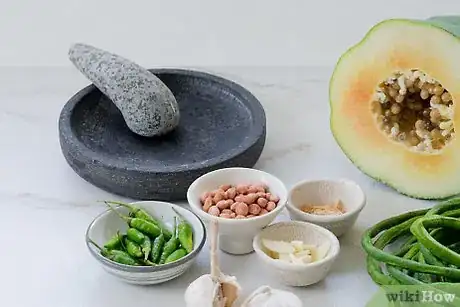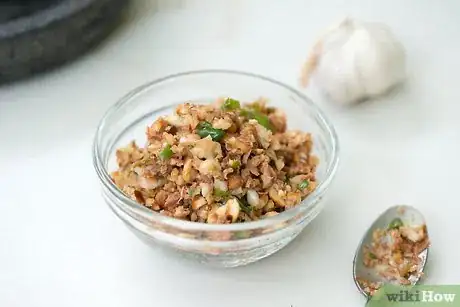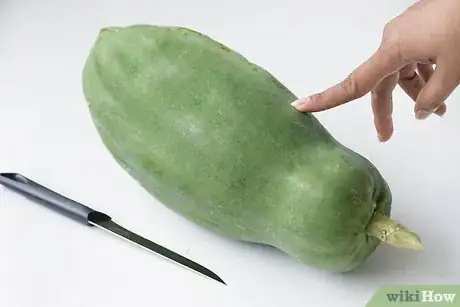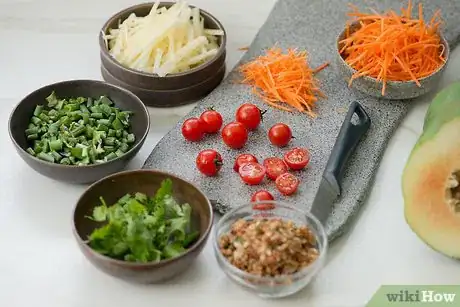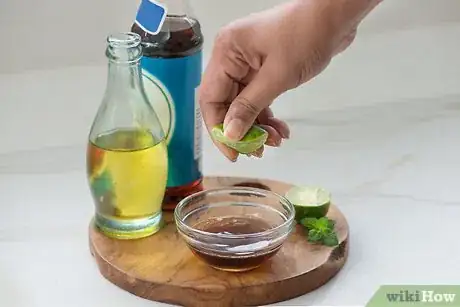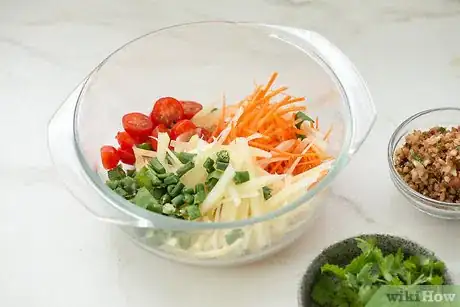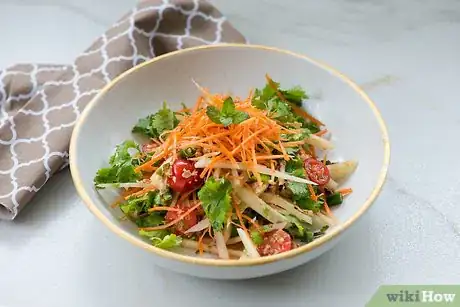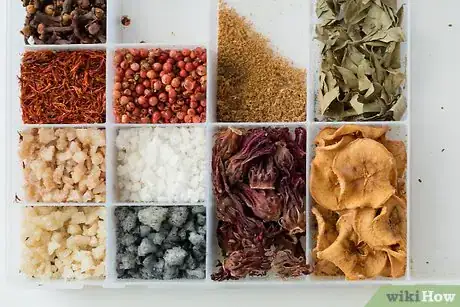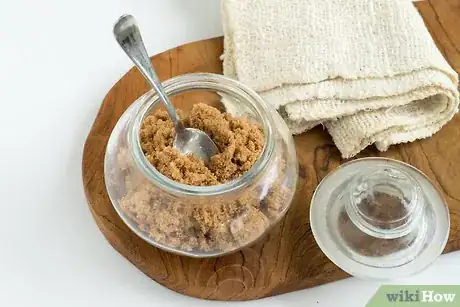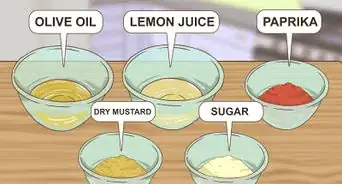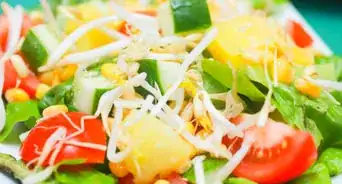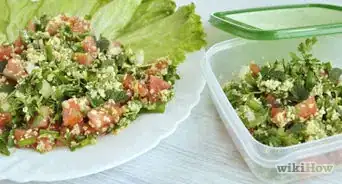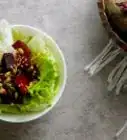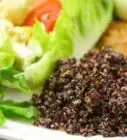This article was co-authored by wikiHow Staff. Our trained team of editors and researchers validate articles for accuracy and comprehensiveness. wikiHow's Content Management Team carefully monitors the work from our editorial staff to ensure that each article is backed by trusted research and meets our high quality standards.
This article has been viewed 69,819 times.
Learn more...
Papaya salad, also known as som tam in Thailand and other parts of Southeast Asia, is a traditional side dish made from green papaya fruit, savory vegetables and herbs and a healthy amount of spice. Its fresh and complex flavors are sure to be a hit with even the pickiest eaters. Best of all, papaya salad is healthy, easy to make and doesn’t require a lot of preparation or cook time.
Ingredients
Salad
- 1 medium sized green papaya (shredded or julienned)
- 1 large carrot (shredded)
- 1 cup raw bean sprouts
- 10-12 cherry tomatoes (halved)
- 1/4 cup scallions (sliced thin)
- 2-3 sprigs fresh cilantro (diced or in strips)
- 2-3 sprigs fresh Thai basil (diced or in strips)
Aromatics (Crushed)
- 1/2 cup yardlong beans (or French green beans)
- 4-5 Thai bird's eye chilies or Serrano peppers
- 2 cloves garlic
- 1 tbsp dried shrimp
- 1/2 cup raw peanuts (crushed or chopped)
Dressing
- 1-2 tbsps Thai fish sauce
- 1/2 cup lime juice
- 1 tbsp palm sugar (or light brown sugar)
Steps
Crushing the Aromatic Ingredients
-
1Gather your ingredients. To get started, you should lay out all the aromatic ingredients you will be using to flavor the salad. This includes the dried shrimp, garlic, peanuts, yardlong beans (French green beans can be used instead) and chili peppers. Som tam is traditionally made by grinding or “bruising” the dry ingredients in a mortar and pestle before incorporating them into the fresh fruits and vegetables that make up the salad.[1]
- Look for less common ingredients like dried shrimp and Thai fish sauce at your local Asian supermarket.
-
2Have a mortar and pestle or large bowl ready. Rather than chopping or pureeing the dry ingredients, they should be crushed to get the proper flavor and consistency. The best way to do this is with a mortar and pestle. If you don’t own or have access to one, you can simply place the items in a large mixing bowl and mash them with the bottom of a broad spoon.[2]
- Because they’re so hard, the peanuts are the one exception and may need to be chopped if you’re not using a mortar and pestle.
- Authentic som tam is often made entirely in the same mortar.
Advertisement -
3Crush the ingredients to release their flavors. Take the dry ingredients and grind them with the pestle or spoon until they are soft but intact. The purpose of this process is not to completely break down the ingredients but to unlock their pungent flavors while reducing them to an edible size and texture. For best results, crush the shrimp, garlic, beans, peanuts and chilies individually.[3]
- Try not to crush the dry components until they’re too fine. A coarse, pulpy texture is what you’re after.
- If you want to save time, or you’d prefer a more even consistency, you can pulse the dry ingredients a few times in a food processor until they’re the right size.
-
4Combine the crushed ingredients. Once they’ve been lightly ground, set the dry ingredients aside in a separate bowl. It’s best to keep them separated from the papaya and other vegetables until it’s time to toss them together. This will ensure that the finished salad is fresh and crisp and retain the distinct notes of each of its ingredients.
- The flavors of the aromatics will begin to mingle as they rest.
Mixing the Salad and Dressing
-
1Prep the papaya. The papaya used for som tam needs to be green (picked just before it’s ripe) and cut into matchstick-sized shreds. When you’re doing your shopping, look for green papaya that has already been shredded. This will save you a lot of prep time and shouldn’t have much of an effect on the freshness of the flavor, since unripe papaya is so dry. If you don’t have any luck finding it pre-shredded, you can take the time to julienne it yourself or use a Kiwi shredder.[4]
- Look over the papaya closely before you buy it. It should be a deep green color on the outside and be firm to the touch, with very little give.
- If you’re using fresh, whole papaya, it will need to be seeded before it’s shredded.
- You can also shred the papaya with an ordinary kitchen grater, although the pieces may be slightly smaller and thinner.[5]
-
2Dice the other vegetables. Cut the tomatoes into halves or quarters. Shred or julienne the carrots. Dice the scallions. Chop the Thai basil and cilantro or slice them into fine strips. Bean sprouts can be added whole or cut into smaller pieces. Combine these with the papaya shreds and mix it all together by hand.[6]
- The papaya should make up the bulk of the salad, with the rest of the vegetables there to supplement the flavor and texture.
-
3Mix the dressing. Put the lime juice, palm sugar, fish sauce and salt into a separate bowl and whisk them together until the mixture forms a thin liquid. Taste the dressing to make sure it’s right. In a well-made som tam, all flavors should be represented equally: sweet, salty, tart, zesty and bitter.[7]
- Add the fish sauce to taste. It has a very unique flavor profile that works best when balanced by other flavors, and can easily become overpowering if you use too much.
-
4Combine and serve. Add the crushed dry ingredients to the papaya, carrots, scallions, bean sprouts and herbs. Drizzle the dressing over the top. Toss until all the components are evenly distributed throughout the salad and coated with the dressing. If you desire, top with extra crushed peanuts, cilantro or basil and enjoy![8]
- Papaya salad refrigerates well and will stay fresh for up to 3 days, though the acids in the dressing may cause it to soften up somewhat.
- This recipe makes between 3-4 servings.
-
5Finished!
Adjusting the Recipe
-
1Substitute other root vegetables for papaya. Papaya can be hard to find in most places, especially unripe, the way it needs to be for som tam. If you have trouble finding papaya, simply swap it out for kohlrabi, cabbage mix, daikon radish or cucumber. Any of these mild root vegetables will have the right crunchy texture, and when shredded or julienned will be perfect for soaking up the tangy dressing.[9]
- When substituting other vegetables for papaya, make sure you buy them before they’re fully ripe so that they’ll be firm.
- Mild melons like cantaloupe can also work as a tasty replacement.
-
2Use salt in place of fish sauce. If you’re a vegan, or just find fish sauce to be particularly unpalatable, just add a little extra salt to the dressing instead. A little white vinegar can also do the trick, and will provide the liquid you need to blend the dressing. The main purpose of the fish sauce is impart a salty, pungent flavor, so it’s easy to achieve the same effect without having to work with an ingredient you can’t stomach.[10]
- Other salty condiments like soy sauce are not recommended, as they’ll throw off the flavors of the salad.
-
3Add brown sugar for sweetness. Palm sugar is the go-to sweetener for most Southeast Asian and Malaysian cuisine, but it’s not available everywhere, and it might taste a bit strange to those who aren’t used to it. Luckily, light brown sugar makes a perfect replacement. It’s sweet and just a bit earthy, and it will dissolve and thicken well in the lime juice.[11]
- Play around with the amount of sugar that goes into the dressing if you want to offset the spice of the chilies.
-
4Come up with your own variations. Since the components of som tam are prepared individually and then assembled, it’s an easy recipe to customize. Adjust the amounts of herbs and aromatics to taste, or substitute some of your other favorite vegetables instead. You might choose to crank up the heat from the chilies, or leave them out altogether. The choices are nearly endless!
- Top the salad with fresh grilled shrimp, beef or chicken rather than dried shrimp for a heartier meal version of som tam.[12]
Things You'll Need
- Mortar and pestle (or mixing bowl and large spoon)
- Food processor (optional)
- Sharp knife
- Serving dish
Warnings
- Sample everything as its being prepared to make sure it tastes right. With such flavorful ingredients, it only takes a little too much of one item to offset the balance of the dish.⧼thumbs_response⧽
- Add the chili peppers to taste a little at a time. If it's not spicy enough for your liking, you can always add more, but if you add too many at once there will be no way to cool it off.⧼thumbs_response⧽
References
- ↑ https://www.thekitchn.com/recipe-green-papaya-salad-som-tam-99519
- ↑ http://cooking.nytimes.com/recipes/1012589-green-papaya-salad
- ↑ http://shesimmers.com/2010/06/som-tam-tutorial-how-to-make-thai-green.html
- ↑ http://shesimmers.com/2010/06/som-tam-tutorial-how-to-make-thai-green.html
- ↑ https://www.theguardian.com/lifeandstyle/2015/jul/23/how-to-make-perfect-som-tam-thai-salad
- ↑ https://www.thekitchn.com/recipe-green-papaya-salad-som-tam-99519
- ↑ http://www.thaitable.com/thai/recipe/green-papaya-salad
- ↑ https://www.eatingthaifood.com/thai-green-papaya-salad-recipe/
- ↑ https://www.theguardian.com/lifeandstyle/2015/jul/23/how-to-make-perfect-som-tam-thai-salad
About This Article
To make papaya salad, start by crushing yardlong beans, chilies, garlic, shrimp, and peanuts to release their flavors and then mix them together. Next, cut papaya into matchstick-size shreds and cut carrots, sprouts, tomatoes, scallions, cilantro, and basil. After that, combine them all together. To mix the dressing, whisk together lime juice, sugar, fish sauce, and salt until it forms into a thin liquid. Then, add the crushed ingredients to the salad, drizzle the dressing over the top, and toss. If you’d like, you can top with cilantro or basil before serving. For more tips, like how to pick the best papaya, read on!

